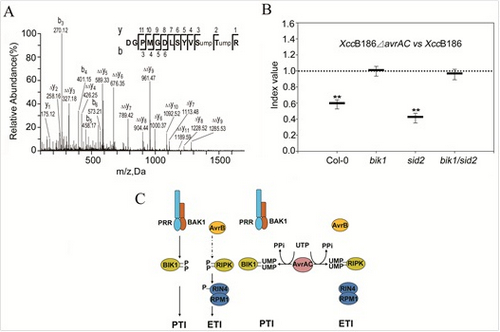Plants sense molecules derived from pathogenic microorganisms through cell surface immune receptors and intracellular immune receptors, activate natural immunity, and resist infection by pathogens; and pathogenic bacteria interfere with the latter's cell activity by secreting effector proteins to plant cells, Increase its ability to infect. The biochemical function and molecular mechanism of most effector proteins are not clear. Studying the target proteins and action mechanisms of these effector proteins in the host will help us to understand the mechanism of bacterial pathogenicity and plant immune response.
Xanthomonas campestris pv campestris (Xcc, Xanthomonas campestris pv campestris) is an important pathogenic bacteria that causes black rot in cruciferous plants worldwide. AvrAC is an effector protein widely present in Xcc strains, using Xcc and Arabidopsis interaction model system, Zhou Jianmin Research Group, State Key Laboratory of Plant Genomics, Institute of Genetics and Developmental Biology, Chinese Academy of Sciences and Professor He Chaozu, Hainan University The cooperation of the research group revealed the unique biochemical function and molecular mechanism of AvrAC.
They found that AvrAC directly interacts with the two important cytoplasmic receptor kinases BIK1 and RIPK in the Arabidopsis natural immune signaling pathway to strongly inhibit the plant's natural immune response and enhance the pathogenicity of pathogenic bacteria on the host plant. Further research found that AvrAC is a uridine monophosphate transferase that specifically modifies the conserved serine and threonine in BIK1 and RIPK activation loops, and these two amino acids happen to be the phosphorylation sites of BIK1 and RIPK, which activate kinase And signal transduction function is essential. After being modified by AvrAC, the phosphorylation site is occupied by UMP, these two kinases cannot activate the immune signaling pathway, and the plant becomes more susceptible.
AvrAC is currently the only reported bacterial effector protein with uridine monophosphate transferase activity. The results clarify how pathogenic bacteria use a unique biochemical and molecular mechanism to accurately attack plant immune systems.
The research results have been published online in the journal Nature on April 15 with the original title of A Xanthomonas uridine 5'-monophosphate transferase inhibits plant immune kinases. PhD student Feng Feng is the first author of the article, and Professor He Chaozu of Hainan University is the co-corresponding author. The research was funded by the 973 project of the Ministry of Science and Technology.

AvrAC uridine monophosphate modified plant immune receptor kinase inhibits plant natural immune signal transduction. The picture is from (Feng et al., 2012) A. Tandem mass spectrometry analysis shows that AvrAC can add UMP modification to the conserved serine and threonine of BIK1 activation loop in plant cells. B. AvrAC's contribution to the pathogenicity of Xcc in Arabidopsis depends on BIK1. Wild-type and avrAC mutant strains were inoculated with different Arabidopsis materials for competition index analysis. C. AvrAC inhibits the biochemical and molecular mechanisms of plant immune responses. Under normal conditions (left), plant cell surface immunoreceptors PRRs phosphorylate BIK1 after recognizing PAMP molecules of ligand pathogens to activate PTI. After entering the plant cells, the effector protein AvrB can induce RIPK to phosphorylate RIN4 to activate the immune pathway mediated by the intracellular immune receptor RPM1. When Xcc infects plants (right), AvrAC performs UMP modification on BIK1 and RIPK, preventing their phosphorylation, inhibiting their kinase activity and thus inhibiting downstream signal transduction.
The Submersible LED Spotlight is a powerful and versatile lighting solution designed for various applications. With its waterproof design, this spotlight is perfect for illuminating underwater environments such as ponds, fountains, and aquariums.
Featuring a rotation angle capability, the spotlight allows you to adjust the direction of the light beam, providing flexibility in highlighting specific areas or objects within your aquatic setting. Whether you want to showcase a stunning fish or create a captivating water feature, this spotlight can be easily positioned to meet your desired lighting needs.
The Submersible LED Spotlight is equipped with high-brightness LEDs, ensuring bright and vibrant illumination. The LEDs provide a clear and crisp light output, enhancing the beauty of your underwater landscape and bringing out the natural colors of aquatic plants and creatures.
Constructed with durable ABS material, this spotlight is built to withstand the rigors of underwater use. The ABS material offers excellent resistance to water and corrosion, ensuring long-lasting performance even in submerged conditions

Submersible LED Spotlight,LED Spotlight for Aquarium,LED Spot Light for Fish Tank,Aquarium LED SpotLight
Shenzhen GAKO Aquatics Products Co., Ltd , https://www.gako-aquarium.com